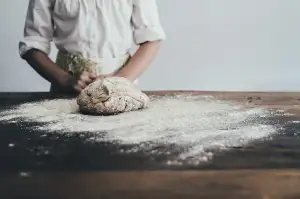Master the Art of Cleaning a Cast Iron Skillet: A Step-by-Step Guide for a Spotless Home Kitchen

Cleaning a cast iron skillet is an essential task for maintaining its longevity and ensuring optimal cooking performance. A well-maintained skillet not only enhances the flavors of your food but also prevents rusting and prolongs its lifespan. Regular cleaning removes built-up residue, prevents food from sticking, and allows for even heat distribution. In this step-by-step guide, we will explore the best techniques to keep your cast iron skillet spotless, ensuring a clean and healthy kitchen environment.
Gather necessary supplies for cleaning
To effectively clean a cast iron skillet, it is important to gather the necessary supplies beforehand. Here's a list of items you will need:
1. Hot water: Make sure you have access to hot water for rinsing and cleaning purposes.
2. A stiff brush or sponge: Look for a brush or sponge with firm bristles that can easily remove any food residue without damaging the skillet's surface.
3. Mild dish soap: Choose a gentle dish soap that won't strip away the skillet's seasoning but can still help remove stubborn stains or grease.
4. Paper towels or clean cloth: These will be used for drying the skillet after cleaning.
5. Cooking oil or shortening: You'll need oil or shortening to season the skillet after cleaning and prevent rusting.
By having these supplies ready, you'll be well-prepared to tackle the task of cleaning your cast iron skillet effectively and efficiently.
Preparing the skillet for cleaning
Before diving into the cleaning process, it is essential to prepare the cast iron skillet properly. Start by allowing the skillet to cool completely after use. Never attempt to clean a hot skillet as it can cause burns or damage. Once cooled, gently scrape off any excess food particles using a spatula or a stiff brush. Be careful not to scratch the surface of the skillet while doing so. This step will make the cleaning process much easier and more effective.
Using gentle scrubbing techniques to remove residue
Using gentle scrubbing techniques is essential to remove any residue from your cast iron skillet. Harsh scrubbing can damage the seasoning and surface of the skillet, so it's important to be gentle yet effective.
Start by using a nylon brush or sponge to gently scrub the surface of the skillet. Avoid using abrasive materials such as steel wool, as they can scratch the skillet.
If there are stubborn food particles stuck to the skillet, create a paste using equal parts coarse salt and water. Apply this paste to the affected areas and use a gentle circular motion with your brush or sponge to loosen the residue.
For extra stubborn residue, you can also use a plastic scraper or spatula to gently scrape off any remaining food particles. Be careful not to apply too much pressure, as this can damage the surface of the skillet.
Continue scrubbing until all residue has been removed. Rinse the skillet with warm water to remove any remaining salt or residue.
Remember, patience is key when cleaning a cast iron skillet. Take your time and be thorough in your scrubbing technique to ensure that all residue is removed without damaging the skillet's surface.
Rinsing and drying the skillet thoroughly
After scrubbing away the residue from your cast iron skillet, it's crucial to rinse it thoroughly to remove any remaining soap or cleaning solution. Soap can strip away the seasoning that gives your skillet its non-stick surface and adds flavor to your dishes. Hold the skillet under warm running water and use your hands or a soft brush to ensure all traces of soap are gone.
Once you've rinsed off the soap, it's time to dry the skillet completely. Leaving any moisture on the surface can lead to rusting. Use a clean towel or paper towels to pat dry the skillet, making sure to remove all excess water. Don't forget to dry both the inside and outside of the skillet, as well as the handle.
To ensure thorough drying, you can also place the skillet on a stovetop burner set on low heat for a few minutes. This will help evaporate any remaining moisture. Just be cautious not to leave it unattended or keep it on high heat as this may damage the seasoning.
Remember, proper drying is essential for maintaining your cast iron skillet's longevity and preventing rust formation. So take your time and make sure every nook and cranny is completely dry before moving on to the next step in caring for your beloved kitchen tool.
Applying a thin layer of oil to prevent rusting
Applying a thin layer of oil to prevent rusting is an essential step in maintaining the longevity of your cast iron skillet. After rinsing and drying the skillet thoroughly, it is crucial to coat the entire surface with a thin layer of oil. This helps create a protective barrier against moisture, preventing rust from forming.
To apply the oil, you can use a paper towel or a clean cloth. Make sure to spread the oil evenly across the skillet, including the handle and any other exposed areas. Be careful not to use too much oil as it may become sticky or leave a residue.
The type of oil you use is also important. Traditional choices include vegetable oil, canola oil, or flaxseed oil. These oils have high smoke points and are ideal for seasoning cast iron skillets.
Once you've applied the oil, heat your skillet on low heat for a few minutes to allow it to absorb into the metal. This process helps create a natural non-stick surface over time.
Remember to repeat this process after each cleaning session or whenever you notice signs of rust starting to develop. Regularly applying a thin layer of oil will keep your cast iron skillet in pristine condition and ready for future cooking adventures.
By taking these simple steps to prevent rusting, you can ensure that your cast iron skillet remains an indispensable tool in your kitchen arsenal for years to come. So don't forget this crucial step in maintaining your cast iron skillet's quality and longevity!
Storing the skillet properly for future use
Storing the skillet properly for future use is crucial to maintain its quality and prevent rusting. After cleaning and drying the skillet, make sure it is completely cool before storing. Avoid stacking other cookware on top of it to prevent any scratches or damage. To further protect the skillet, place a paper towel or cloth inside to absorb any moisture and prevent rust formation. Finally, store it in a dry and well-ventilated area, away from any humidity or moisture sources. By following these storage guidelines, you can ensure that your cast iron skillet remains in excellent condition for many years to come.
In conclusion, regular cleaning of a cast iron skillet is essential for maintaining its longevity and performance in the kitchen. By following the step-by-step guide outlined above, you can ensure that your skillet remains spotless and ready for use at all times. Proper cleaning not only removes residue and prevents rusting but also helps to preserve the flavor of your dishes. With a clean skillet, you can embrace freshness in every food creation and enjoy the many benefits of cooking with cast iron. So, make it a habit to clean your skillet after each use and reap the rewards of a well-maintained kitchen tool.
Published: 20. 12. 2023
Category: Home



